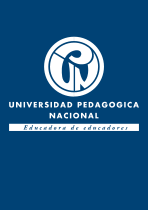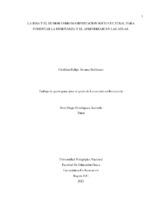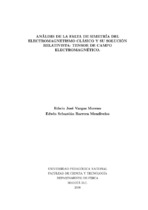Mostrar el registro sencillo del ítem
La teoría de la aromaticidad: un programa de investigación.
| dc.contributor.author | Fuentes Medina, Pilar | spa |
| dc.contributor.author | Muñoz Albarracín, Yoli | spa |
| dc.date.accessioned | 2021-08-02T16:53:07Z | |
| dc.date.available | 2021-08-02T16:53:07Z | |
| dc.date.issued | 2003-07-01 | |
| dc.identifier | https://revistas.pedagogica.edu.co/index.php/TED/article/view/5571 | |
| dc.identifier | 10.17227/ted.num14-5571 | |
| dc.identifier.issn | 2323-0126 | |
| dc.identifier.issn | 2665-3184 | |
| dc.identifier.uri | http://hdl.handle.net/20.500.12209/15602 | |
| dc.description.abstract | En el presente artículo se discurre sobre la construcción de la teoría de la aromaticidad partiendo de la propuesta de August Friederich Kekulé en 1865; se tienen en cuenta los aportes hechos a la misma por otros autores, los cuales fundamentaron la teoría dando explicación a los interrogantes que surgieron durante su elaboración para ser aceptada por una comunidad científica . El análisis que se pretende realizar, parte de la reconstrucción de la historia interna, desde una aproximación a la propuesta Lakatosiana, en la que se examinan los problemas que la teoría resolvió, las preguntas que no respondió, los programas de investigación en competencia y finalmente los aportes a la comunidad científica. | spa |
| dc.format.mimetype | application/pdf | spa |
| dc.language.iso | spa | |
| dc.publisher | Editorial Universidad Pedagógica Nacional | spa |
| dc.relation | https://revistas.pedagogica.edu.co/index.php/TED/article/view/5571/4588 | |
| dc.rights.uri | https://creativecommons.org/licenses/by-nc/4.0 | |
| dc.source | Tecné, Episteme y Didaxis: TED; Núm. 14 (2003) | spa |
| dc.source | Tecné, Episteme y Didaxis: TED; No. 14 (2003) | spa |
| dc.source | Tecné, Episteme y Didaxis: TED; n. 14 (2003) | spa |
| dc.subject | Aromaticidad | spa |
| dc.subject | Atomicidad | spa |
| dc.subject | Tetravalencia | spa |
| dc.subject | Historia interna | spa |
| dc.subject | teoría de tipos | spa |
| dc.subject | Teoría de radicales | spa |
| dc.subject | Teoría de sustitución | spa |
| dc.subject | Teoría Electrónica de Valencia | spa |
| dc.subject | Regla de Hückel | spa |
| dc.title | La teoría de la aromaticidad: un programa de investigación. | spa |
| dc.subject.keywords | Aromaticity | eng |
| dc.subject.keywords | Atomicity | eng |
| dc.subject.keywords | Tetravalency | eng |
| dc.subject.keywords | Internal history | eng |
| dc.subject.keywords | Types theory | eng |
| dc.subject.keywords | Radical theory | eng |
| dc.subject.keywords | Sustitution theory | eng |
| dc.subject.keywords | Electronic theory of valence | eng |
| dc.subject.keywords | Hückel’s rule | eng |
| dc.rights.accessrights | info:eu-repo/semantics/openAccess | |
| dc.rights.accessrights | http://purl.org/coar/access_right/c_abf2 | |
| dc.relation.references | ARMSTRONG, H.E.J (1887) Chem. Soc. Pp 51, 258 – 268. | eng |
| dc.relation.references | BAEYER, A.(1888) Liebigs Annalen der Chemie, pp 245, 103-185 | gem |
| dc.relation.references | BROWN C, (1860) “Models and structural diagrams in the 1860s” Extracts from proceedings of the Royal Institution, 4, pp 401-430 | eng |
| dc.relation.references | CLAUS Y KOERNER (1867) “Completion of Koerner`s Proof that the Hydrogens Of Benzene are Homotopic. An application of group theory” Journal Amer. Chem. Soc. Pp 102. | eng |
| dc.relation.references | COUPER, A.S.(1858) “ On a New Chemical Theory”. In: Philosophical Magazine. Nº 4 Vol. 16. pp 104-116. | eng |
| dc.relation.references | DEWAR, M.J.S. (1945) “Autobiography: Dewar, M J S.A Semiempirical life”. Nature.Pp 155, 50-51 | eng |
| dc.relation.references | DEWAR. J, (1866) “Dewar`s Brass strip models” From Proceedings of the Royal Society of Edinburg, VI session pp 82-86. | eng |
| dc.relation.references | DUMAS (1840) “ On the substitution law and the theory of types (leter to justus Liebig)” Annalen der Chemie and Pharmacie vol 33 pp 308 | eng |
| dc.relation.references | FRANKLAND, E. (1852) “On a New series of organic bodies containing metals” Classic in the Theory Of Chemical Combination, New York pp 76-108. | eng |
| dc.relation.references | GAGLIARDI, R. (1988) “Cómo Utilizar La Historia De Las Ciencias En La Enseñanza De Las Ciencias”. En: Enseñanza de las ciencias, 6(3), 291-296. | spa |
| dc.relation.references | GAGLIARDI, R. y GIORDAN, A. (1986). “La Historia De Las Ciencias: Una Herramienta Para La Enseñanza”. Enseñanza de las ciencias, 4 (3), 253-258. | spa |
| dc.relation.references | GALLEGO, B. Y PÉREZ, M (1997) La enseñanza de las ciencias experimentales. El constructivismo del caos Editorial Magisterio. Bogotá. | spa |
| dc.relation.references | GARRAT, P.J. (1974). Aromaticidad . Madrid, España: ALHAMBRA. | spa |
| dc.relation.references | HOFMAN (1865) “Hoffman ́s Croquet balls models” Extracts from proceedings of the Royal Institution, 4 pp 401-430. | eng |
| dc.relation.references | KEKULÉ, A.(1865). “ Study on aromatic compounds” In: Annalen der Chemie. Nº 137. pp 129-196. | eng |
| dc.type.local | Artículo de revista | spa |
| dc.type.coar | http://purl.org/coar/resource_type/c_6501 | eng |
| dc.type.driver | info:eu-repo/semantics/article | eng |
| dc.description.abstractenglish | In this article we want to discuss about building aromaticity theory since August Friederich Kekule’s proposal made it in 1865; we must release the contributions make to its by others authors no less importants , which given a solid bases to the theory and a satisfactory explications to several questions that emerged during the time its was built for be to accepted by a scientifican community. The analysis that we wish to do, begin with the internal history reconstruction since an approach Lakatos’s works, for what we will review the problems that the theory can solve, the questions that it can ́t give an answer, the investigations programs which was in competence each other and finally the contributions to the scientifican community . | eng |
| dc.type.version | info:eu-repo/semantics/publishedVersion | |
| dc.rights.creativecommons | Attribution-NonCommercial 4.0 International |
Ficheros en el ítem
| Ficheros | Tamaño | Formato | Ver |
|---|---|---|---|
|
No hay ficheros asociados a este ítem. |
|||
Este ítem aparece en la(s) siguiente(s) colección(ones)
-
TED: Tecné, Episteme y Didaxis [1388]
Pone a discusión artículos originales de la comunidad de educadores e investigadores nacionales e internacionales en Educación en Ciencias Experimentales, Matemáticas y Tecnología, presentando los diversos avances en estos campos de conocimiento.



